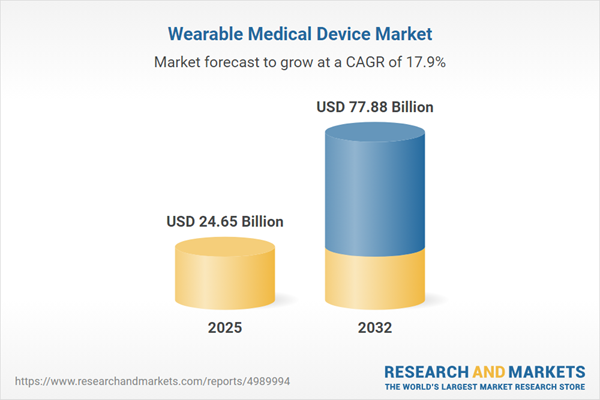Speak directly to the analyst to clarify any post sales queries you may have.
The wearable medical device market is advancing connected healthcare by empowering organizations with real-time patient health tracking, data-driven decision support, and secure integration across healthcare environments. Senior executives are leveraging these innovations to improve patient outcomes and streamline operations as healthcare systems adapt to digital transformation.
Market Snapshot: Wearable Medical Device Market Size & Growth Trends
In 2024, the wearable medical device market reached USD 20.87 billion, projected to grow to USD 24.65 billion by 2025 at a compound annual growth rate of 17.89%. This expansion is propelled by advancements in sensor technology, robust data analytics, and enhanced device connectivity. Healthcare organizations are pursuing digital transformation through improved clinical workflows, greater efficiency, and flexible solutions designed to support evolving care standards and meet new regulatory demands. As healthcare delivery increasingly relies on automation, continuous patient monitoring, and digitally integrated processes, the market remains a cornerstone in connected health innovation.
Scope & Segmentation: Advancing Connected Health Technology
This report provides leaders with the intelligence needed to optimize technology investments and align digital strategies with dynamic healthcare requirements. Through comprehensive segmentation, it addresses global and regional developments, enabling strategic decisions around technology deployment, care delivery, and digital workflow optimization for diverse healthcare stakeholders.
- Product Types: Covers activity trackers, wearable blood pressure monitors (for both invasive and non-invasive measurements), systems for continuous glucose management, heart rate monitors (wrist and chest), digital thermometers, sleep monitoring devices, and modular sensors supporting programs for chronic disease care.
- Applications: Reflects use in cardiac and blood pressure tracking, diabetes management, rehabilitation, ongoing fitness and wellness monitoring, temperature and sleep assessments, along with long-term preventive health strategies.
- End Users: Includes ambulatory surgical centers, large hospital systems, in-home health providers, fitness and wellness companies, as well as clinical research teams emphasizing digital healthcare innovation.
- Technologies: Encompasses electrochemical biomarker sensors, microelectromechanical systems (MEMS) that enable device miniaturization, photoplethysmography for vital sign monitoring, spectroscopy for health analytics, and piezoelectric sensors for precise performance.
- Connectivity: Employs secure Bluetooth, NFC, Wi-Fi, and cellular protocols, facilitating seamless data transfer and ensuring robust integration across both institutional and remote care workflows.
- Distribution Channels: Incorporates hospital procurement, pharmaceutical networks, medical device distributors, contract-based delivery, and rapidly expanding e-commerce platforms for wide-reaching solution deployment.
- Regions and Countries: Encompasses North America, Latin America, Europe, Middle East, Africa, and Asia-Pacific, with significant growth observed in China, India, and Japan as adaptive regulatory environments support rapid market adoption.
- Key Companies: Highlights industry leaders such as Dexcom, Abbott Laboratories, Medtronic, Johnson & Johnson, Siemens Healthineers, Masimo, Philips, Insulet, Zimmer Biomet, and GE HealthCare driving innovation and integration initiatives.
Key Takeaways for Senior Decision-Makers
- Wearable medical devices enable care providers to extend patient engagement beyond clinics, promoting timely interventions and consistent health management.
- Integration of artificial intelligence delivers actionable insights that inform clinical strategy and foster personalized care pathways across diverse patient populations.
- Seamless interoperability with established health IT ecosystems supports secure data flow, aiding compliance and scaling of digital health programs.
- Procurement approaches are shifting to digital-first, validated solutions that address rising data volumes and maintain streamlined workflows amid increasing complexity.
- Ongoing focus on regulatory adaptation and IT infrastructure investment underpins operational resilience, enabling organizations to evolve alongside the digital health landscape.
Tariff Impact: Navigating Policy Shifts
Changing U.S. tariffs have prompted healthcare organizations to re-evaluate procurement methods and supplier bases. By adopting diversified sourcing and forming global partnerships, healthcare enterprises reinforce supply chain stability while supporting continued advancement in the wearable device segment.
Methodology & Data Sources
Insights presented stem from direct engagements with the market, academic and regulatory publications, and data analysis utilizing established frameworks such as SWOT and Porter’s Five Forces. All findings are validated for their strategic relevance and reliability for executive decision-making.
Why This Wearable Medical Device Market Report Matters
- Empowers organizations with actionable intelligence to inform connected health investment decisions and foster successful digital technology partnerships.
- Supports adaptation to evolving regulatory frameworks and technology standards, enabling leaders to safeguard market position during swift industry changes.
- Delivers evidence-based recommendations and risk-aware analysis to strengthen organizational preparedness and resilience.
Conclusion
Success in the wearable medical device market requires digital agility, regulatory awareness, and prioritization of integration. Effective leaders will drive adaptable, future-ready healthcare models.
Additional Product Information:
- Purchase of this report includes 1 year online access with quarterly updates.
- This report can be updated on request. Please contact our Customer Experience team using the Ask a Question widget on our website.
Table of Contents
3. Executive Summary
4. Market Overview
7. Cumulative Impact of Artificial Intelligence 2025
Companies Mentioned
The companies profiled in this Wearable Medical Device market report include:- Dexcom, Inc.
- Abbott Laboratories
- Medtronic PLC
- Johnson & Johnson
- Siemens Healthineers AG
- Masimo Corporation
- Koninklijke Philips N.V.
- Insulet Corporation
- Zimmer Biomet Holdings, Inc.
- GE HealthCare
Table Information
| Report Attribute | Details |
|---|---|
| No. of Pages | 195 |
| Published | November 2025 |
| Forecast Period | 2025 - 2032 |
| Estimated Market Value ( USD | $ 24.65 Billion |
| Forecasted Market Value ( USD | $ 77.88 Billion |
| Compound Annual Growth Rate | 17.8% |
| Regions Covered | Global |
| No. of Companies Mentioned | 11 |









